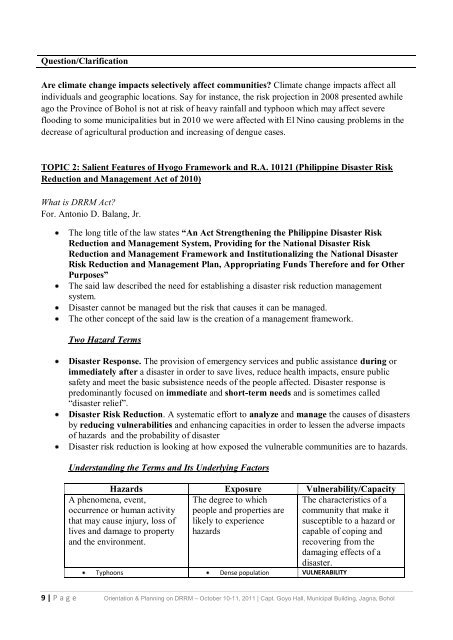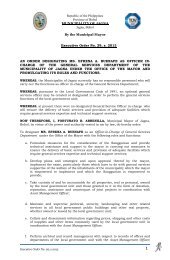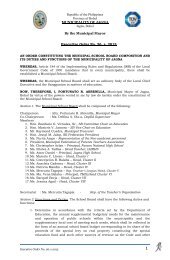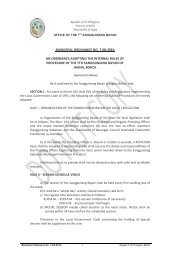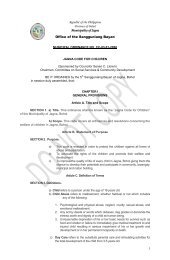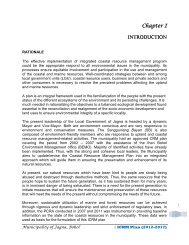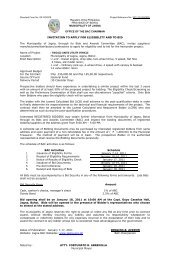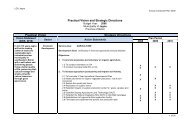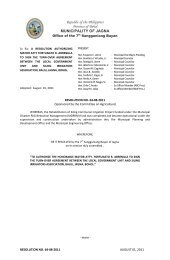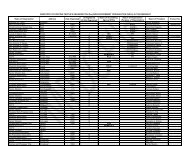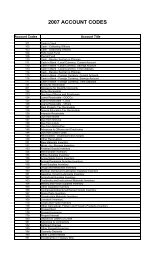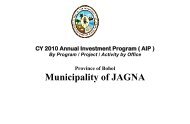DRRM Orientation to Punong Barangays of Jagna
DRRM Orientation to Punong Barangays of Jagna
DRRM Orientation to Punong Barangays of Jagna
Create successful ePaper yourself
Turn your PDF publications into a flip-book with our unique Google optimized e-Paper software.
Question/Clarification<br />
Are climate change impacts selectively affect communities? Climate change impacts affect all<br />
individuals and geographic locations. Say for instance, the risk projection in 2008 presented awhile<br />
ago the Province <strong>of</strong> Bohol is not at risk <strong>of</strong> heavy rainfall and typhoon which may affect severe<br />
flooding <strong>to</strong> some municipalities but in 2010 we were affected with El Nino causing problems in the<br />
decrease <strong>of</strong> agricultural production and increasing <strong>of</strong> dengue cases.<br />
TOPIC 2: Salient Features <strong>of</strong> Hyogo Framework and R.A. 10121 (Philippine Disaster Risk<br />
Reduction and Management Act <strong>of</strong> 2010)<br />
What is <strong>DRRM</strong> Act?<br />
For. An<strong>to</strong>nio D. Balang, Jr.<br />
The long title <strong>of</strong> the law states “An Act Strengthening the Philippine Disaster Risk<br />
Reduction and Management System, Providing for the National Disaster Risk<br />
Reduction and Management Framework and Institutionalizing the National Disaster<br />
Risk Reduction and Management Plan, Appropriating Funds Therefore and for Other<br />
Purposes”<br />
The said law described the need for establishing a disaster risk reduction management<br />
system.<br />
Disaster cannot be managed but the risk that causes it can be managed.<br />
The other concept <strong>of</strong> the said law is the creation <strong>of</strong> a management framework.<br />
Two Hazard Terms<br />
Disaster Response. The provision <strong>of</strong> emergency services and public assistance during or<br />
immediately after a disaster in order <strong>to</strong> save lives, reduce health impacts, ensure public<br />
safety and meet the basic subsistence needs <strong>of</strong> the people affected. Disaster response is<br />
predominantly focused on immediate and short-term needs and is sometimes called<br />
“disaster relief”.<br />
Disaster Risk Reduction. A systematic effort <strong>to</strong> analyze and manage the causes <strong>of</strong> disasters<br />
by reducing vulnerabilities and enhancing capacities in order <strong>to</strong> lessen the adverse impacts<br />
<strong>of</strong> hazards and the probability <strong>of</strong> disaster<br />
Disaster risk reduction is looking at how exposed the vulnerable communities are <strong>to</strong> hazards.<br />
Understanding the Terms and Its Underlying Fac<strong>to</strong>rs<br />
Hazards Exposure Vulnerability/Capacity<br />
The degree <strong>to</strong> which<br />
people and properties are<br />
likely <strong>to</strong> experience<br />
hazards<br />
A phenomena, event,<br />
occurrence or human activity<br />
that may cause injury, loss <strong>of</strong><br />
lives and damage <strong>to</strong> property<br />
and the environment.<br />
Typhoons Dense population VULNERABILITY<br />
The characteristics <strong>of</strong> a<br />
community that make it<br />
susceptible <strong>to</strong> a hazard or<br />
capable <strong>of</strong> coping and<br />
recovering from the<br />
damaging effects <strong>of</strong> a<br />
disaster.<br />
9 | P a g e <strong>Orientation</strong> & Planning on <strong>DRRM</strong> – Oc<strong>to</strong>ber 10-11, 2011 | Capt. Goyo Hall, Municipal Building, <strong>Jagna</strong>, Bohol


